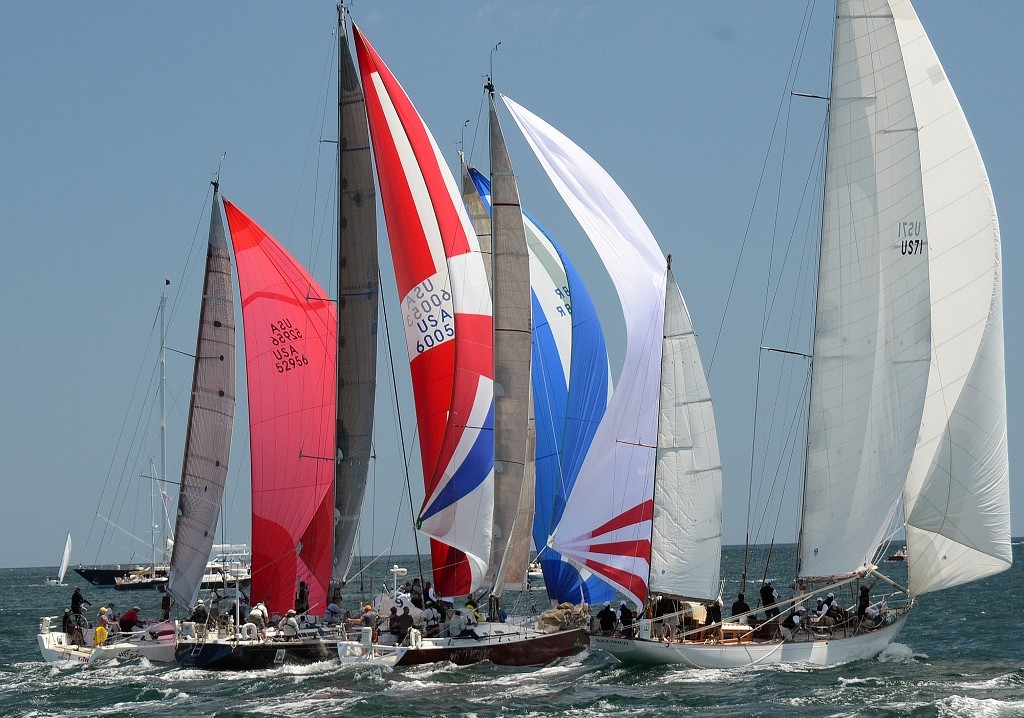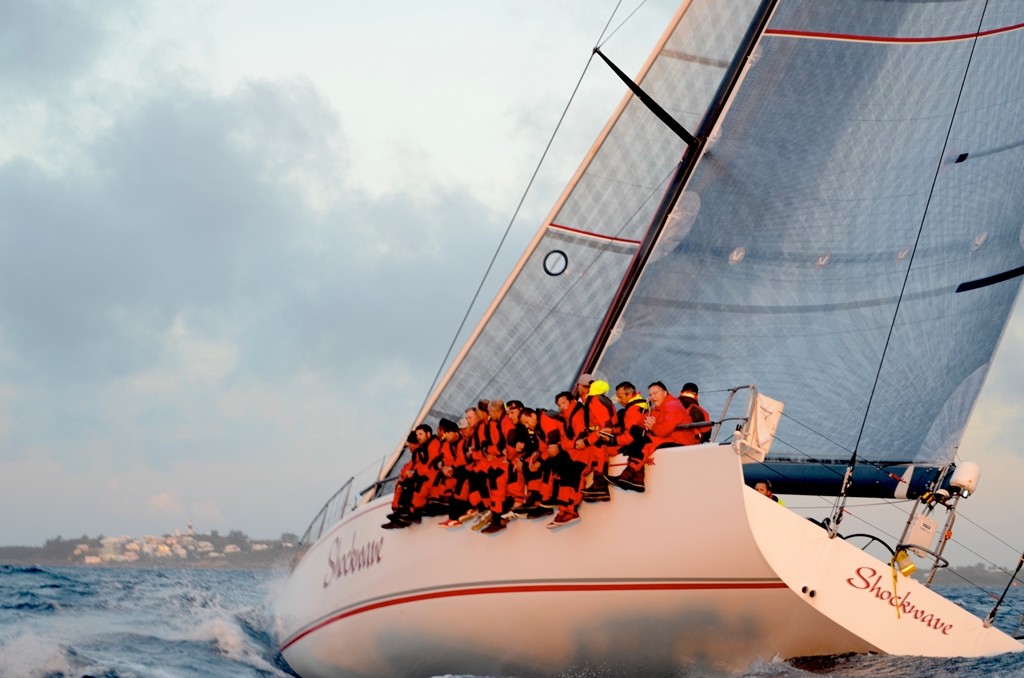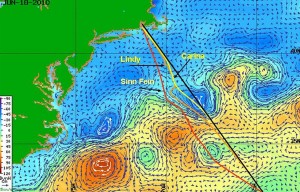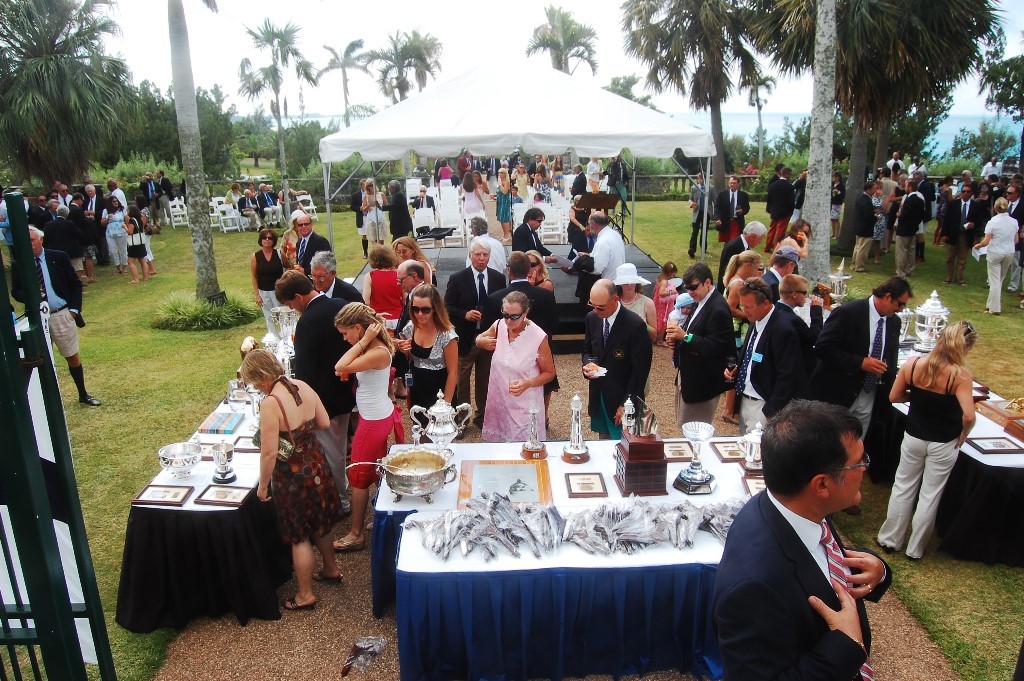The 635-mile biennial Newport Bermuda Race is the oldest regularly scheduled ocean race, one of very few international distance races, and (with the Transpac Race) one of just two of the world’s regularly scheduled races held almost entirely out of sight of land. Founded in 1906, the Bermuda Race is held for the 50th time in 2016.
Its purpose was stated in 1923 by Cruising Club of America Commodore Herbert L. Stone: “In order to encourage the designing, building, and sailing of small seaworthy yachts, to make popular cruising upon deep water, and to develop in the amateur sailor a love of true seamanship, and to give opportunity to become proficient in the art of navigation. . . .”
This year’s event is expected to be the third largest in the race’s history, with approximately 190 boats. The largest fleet, 265 boats, sailed in the centennial race in 2006. The second largest, 197 boats turned out in 2008.
The race attracts sailors from across North America and the globe, with recent entries from Russia, Britain, and China, and always a large turnout of Canadians.
The 2016 fleet is extremely diverse. A total of 23 countries are represented among the sailors, and 55 of the boats have at least one sailor from outside the United States. In addition, 41 US states are represented in this fleet.
 The diverse St. David’s Lighthouse fleet ranges from cutting-edge racers to classics such as the 1938 Sparkman & Stephens yawl Black Watch (right), winner of a special seamanship prize in 2014. (Talbot Wilson)
The diverse St. David’s Lighthouse fleet ranges from cutting-edge racers to classics such as the 1938 Sparkman & Stephens yawl Black Watch (right), winner of a special seamanship prize in 2014. (Talbot Wilson)
A Typical Race
The average crew has ten men or women, many from the same family. Typically, 25-30 percent of captains are sailing their first Newport Bermuda Race in command, but this year the proportion is about 35 percent. The race starts off Newport, R.I., in front of many spectators, on the third Friday in June. It takes more than two hours to get the fleet started. Boats are rated and handicapped under the Offshore Racing Rule, except for the Super Yacht Division.
Depending on the weather and the currents in the Gulf Stream, and the boat’s size and speed, the race takes two to six days. The first boat arrives at the finish line off St. David’s Lighthouse on Sunday or Monday, and the smaller boats arrive between then and Wednesday or Thursday.
 2014 race first-to-finish 72 Shockwave nears St. David’s Lighthouse at dawn. (Talbot Wilson)
2014 race first-to-finish 72 Shockwave nears St. David’s Lighthouse at dawn. (Talbot Wilson)

The crucial navigational and tactical decision concerns the course across the Gulf Stream. Three top boats made these choices in the 2010 race.
The crucial navigational and tactical decision concerns the course across the Gulf Stream. Three top boats made these choices in the 2010 race.The race is demanding. The rules say, “The Newport Bermuda Race is not a race for novices.” The course crosses the rough Gulf Stream and is mostly out of the range of rescue helicopters, and Bermuda is guarded by a dangerous reef. The race is nicknamed “the thrash to the Onion Patch” because most Bermuda Races include high winds and big waves (a combination sailors call “a hard thrash”), and because Bermuda is an agricultural island.
The race demands good seamanship, great care, and a boat that is both well-built and properly equipped. The boats must meet stringent equipment requirements and undergo inspection, and the sailors must also pass a review and undergo training in safety. The bonds formed by these sailors are strong. Numerous sailors have sailed more than 10 races, often with family and friends.
Race Organization
The 2016 race is the 50th since the 1906 founding, and it also marks the 90th anniversary of the relationship between the Cruising Club of America and the Royal Bermuda Yacht Club, serving as co-managers and working through the volunteer Bermuda Race Organizing Committee.
 The traditional prizegiving ceremony at Government House is one of the race’s highlights.
The traditional prizegiving ceremony at Government House is one of the race’s highlights.
There are seven divisions, each for a type of boat. The race has no overall winner (only division winners), though the winning St. David’s Lighthouse Division boat (the largest in the race, and a division dedicated to amateur sailors) is regarded as the race’s top boat.
- St. David’s Lighthouse Division, for normal multi-purpose cruising-racing boats sailed by amateur or mostly amateur crews. This division is the largest at approximately 100 boats. There are limits on the number of professional sailors in these boats, and only amateurs are allowed to steer.
- Gibbs Hill Lighthouse Division, for all-out racing, lightweight, high-performance boats often sailed by professional crews, who may steer. Ten to 15 boats usually enter this division.
- Cruiser Division, for boats that normally cruise, not race, sailed by mostly amateur crews, with only amateur helmsmen. The division usually has about 30 boats.
- Double-Handed Division, for boats sailed by two sailors. Approximately 20 boats usually sail in this division. One crew may be a professional and steer.
- Open Division, for racing boats with cant keels, which tilt from side to side. About five boats usually sail in this division. There is no limit on professionals.
- Spirit of Tradition, for traditional boats, most recently the Bermuda Sloop replica Spirit of Bermuda. No limit on professionals.
- Super Yacht Division. No limit on professionals.
Participation
- Total races (1906-2016)—50.
- Total entries—5,189 boats with approximately 50,000 sailors.
- Total miles sailed (approx.)—3,200,000 miles of blue water.
- Largest fleets—265 (2006), 198 (2008).
- Average fleet size 1990-2014 (except 2006), 162 boats
- The typical fleet is about evenly divided between stock (class) boats and custom boats.
Typical participation:
- First-time Captains, 40 boats (ca. 25 percent)
- Non-North America, 15 boats
- Bermuda and Canada, 11 boats
- New England, 75 boats
- Middle Atlantic, 60 boats
- Deep South, 10 boats
- Midwest, 7 boats
- West Coast, 5 boats
- Service academies, 4 boats
- Cruising Club of America members, 35 boats
Fostering and Recognizing Diversity
In recognition of the great diversity of modern sailing, the race has recently created divisions and classes for unique type of boats (for instance cruisers and double-handers) and has introduced several special awards. Trophies and other prizes (more than 100 in all) are presented by Bermuda’s Governor at a ceremony at Government House, overlooking Bermuda.
- Family prizes for top boats with four or more crewmembers from the same family.
- Regional prizes for the top boat from these regions: Chesapeake Bay, Deep South, Great Lakes, West Coast, and Canada. Prizes are also presented to the top Bermuda boat and the top boat hailing from outside North America.
- A prize for the top boat in the Cruiser Division sailing with a crew of four.
- Prizes for boats with the best combined performance in the Newport Bermuda Race and the following races: Marblehead-Halifax, Marion to Bermuda, and Annapolis to Newport.
- New in 2016 are recognitions for all Youth sailor and a prize for the top-finishing Youth crew. These awards are named for the brothers Olin and Rod Stephens, important yacht designers who first did the Bermuda Race when they were 21 and 19. Youth crews are defined as follows: At least 50% of the yacht’s crew + 1 person shall be between the ages of 14 and 23 years, inclusive, on June 17, 2016. The average age of the Youth Crew shall be at least 17 years. All yachts applying to enter this competition shall be subject to review by the Qualifications Committee and may be required to submit records of the crew’s sailing experience. Open to entries in both St David’s and Cruiser Divisions. Cross-Divisional (“X-DV”) scoring among entries.
The Bermuda Race Roll of Honour recognizes the contributions of sailors to the race’s stature and long history. Honorees are Thomas Fleming Day, race founder in 1906; Clarence Kozlay and Robert Somerset, who together saved the lives of ten sailors from a burning boat in the 1932 Bermuda Race; Sir Eldon Trimingham, who revived the race and represented the Royal Bermuda Yacht Club for many years; Carleton Mitchell, three-time race winner 1956-60; George Coumantaros, skipper with the most elapsed time victories and sailor in 26 Bermuda Races; Olin J. Stephens II, designer of many Bermuda Race winners and a longtime race advisor; and (most recently) Bermudian Warren A.H. Brown, who sailed in 20 Bermuda Races and voyaged to the corners of the seas.
History
First Bermuda Race, May 1906, Brooklyn to Bermuda. There were three starters between 28 and 40 feet in length. The winner of the Sir Thomas Lipton Trophy was Tamerlane, 38-foot yawl owned by Franklin Maier, skippered by Thomas Fleming Day.
Bermuda Race progeny: The race inspired the Fastnet Race in England, the Port-Huron to Mackinac Race on the Great Lakes, and the Off Soundings Club (among others).
Accidents: Boats lost: two (Adriana, fire 1932; Elda, grounding 1956). Lives lost, one.
Fastest race: Rambler, 39 hr., 39 min., 18 sec. (ave. 16 knots), 2012
Slowest race: Venturer, 121:13:12 (ave. 5.2 knots), 1960
Largest winner: Margaret, 93 feet, 1909; (modern) Boomerang, 80 feet, 1996
Smallest winner: Burgoo, 37 feet, 1964
Most victories, skipper—
- 3 (tie)— John Alden in three Malabars (1923, 1926, 1932), and Carleton Mitchell in Finisterre (1956, 1958, 1960)
- 2 (tie)— Robert N. Bavier Sr., Memory (1924) and Edlu (1934); Richard S. Nye, Carina (1952, 1970); Peter Rebovich, Sinn Fein (St. David’s Lighthouse Division 2006, 2008); Rives Potts, Carina (St. David’s Lighthouse Division, 2010, 2012)
Most victories, boat—
- 3—Finisterre (1956, 1958, 1960), Carina (1970 and St. David’s Lighthouse Division, 2010, 2012)
- 2 (tie)—Baruna (1938, 1948) and Sinn Fein, Peter Rebovich (2006, 2008)
Successive victories—
- 3—Finisterre (1956, 1958, 1960)
- 2—Sinn Fein(2006, 2008), Carina (2010, 2012)
Non-U.S. winner: Noryema, U.K., 1972
Freshwater winner: Scaramouche, Chuck Kirsch (Sturgis, Mich.), 1974
Most first to finishes, skipper: 4, George Coumantaros in two Boomerangs (1984, 1990, 1992, 1996). Most first-to-finishes, boat: 3 (tie): Baruna, (1936, 1946, 1948), Bolero (1950, 1954, 1956), Boomerang (1984, 1990, 1992).
Most wins by a yacht designer: Olin Stephens, 14 (1934-1994)
Winning skippers who also won America’s Cups – Harold S. Vanderbilt, Ted Hood
Most races by a sailor:
- 30—Jim Mertz, (every race except two, 1936-2004)
- 26—George Coumantaros
- 24— Edward Greeff and Edwin Gaynor
Most races by a boat under one owner:
- 16, Emily—Edwin Gaynor (1978-2008)
- 15, Prim—Gibbons-Neff family (1954-82, 2008)
Most races by a boat:
- 21, Carina – Richard S. Nye and Rives Potts (1970-2014)
Women sailors:
- First, Thora Lund Robinson, Gauntlet, 1906 (the first race)
- First woman skipper, Queene Hooper Foster, Sephedra, 1986
- Highest placing woman skipper, Sheila McCurdy, Selkie, 2nd, 1994 and 2008
Oldest winning skippers:
- 74—DeCoursey Fales, Niña, 1962
- 72— George Coumantaros (1996) and Peter Rebovich (2008)
Youngest winning skipper: Kyle Weaver, Constellation (US Naval Academy) 1992 (22 years old)
























